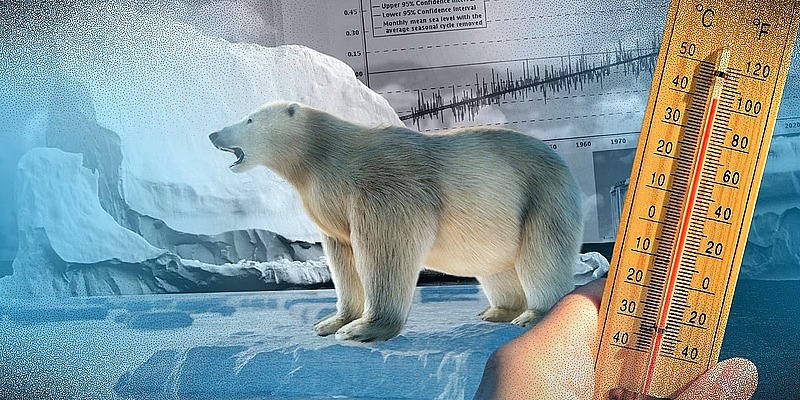As the world’s ocean surface temperature hit a new record-high, scientists warned it could lead to higher risks of extreme weather.
In the Philippines, past disasters show early signs of ocean warming’s devastating impact.
Preliminary data from the National Oceanic and Atmospheric Administration (NOAA) showed that the average temperature of the world’s ocean surface has been 21.1°C since the start of April this year.
It was a new record-high and has surpassed the previous high ocean surface temperature of 21°C recorded in 2016. Scientists warned that increasing ocean temperatures could cause marine heatwaves and a higher risk of extreme weather.
The International Union for Conservation of Nature (IUCN) also stressed that rising ocean surface temperature could cause drought, flooding, sea level rise, and loss of sea ice.
The phenomenon could have a devastating impact on the world’s marine species and ecosystem—as well as humans.
Latest data and study findings in past years have shown the impact of ocean warming on the Philippines.
However, what could be the most destructive manifestation of climate change in the country—linked to rising sea surface temperature—took place in 2013, claiming thousands of lives, destroying billions of pesos worth of infrastructure and livelihood of millions of Filipinos.

What went before: Typhoon Yolanda
On November 8, 2013, Super Typhoon Yolanda (international name: Haiyan) struck the Philippines and was considered as among the country’s worst-ever natural disasters.
In Eastern Visayas, where Yolanda caused massive destruction, around 1.14 million houses were damaged, leaving more than a million families, or 5.13 million individuals, homeless.
The International Labor Organization (ILO) reported that out of more than 14.2 million people affected by Yolanda, 5.9 million were workers whose livelihoods were destroyed.
At least 2.6 million of them were “already in vulnerable employment and living at or near the poverty line before the typhoon.”
The total cost of damage was placed at P95.5 billion. Worst, 6,340 people died and 1,771 went missing and feared dead.
While it was no surprise that a strong typhoon like Yolanda will hit the Philippines, most, if not all survivors shared a grim sentiment— “no one was ready for Yolanda.”
An average of 20 tropical cyclones enter the Philippines, which has been listed as among the world’s most disaster-prone countries.
Ocean warming’s relation to Yolanda
Previous studies have projected that an increase in ocean surface temperature—as a result of global warming—could lead to increases in hurricane frequency, intensity, and destructiveness.
A 2015 study published in the Journal of Environmental Science and Management tested the projection by gaining an insight into the important role and influence of high sea surface temperature (SST)—that may be related to global warming—on the “unusual strength” of Super Typhoon Yolanda.
The scientists who conducted the study found that the strongest environmental factor that might have caused the unusual strength of Yolanda was the SST in the Warm Pool and Western Pacific regions—both of which are close to where the Philippines is located.
They found that the SST is “well-correlated” with the wind strength of historically strong typhoons that hit the country—including Yolanda.
The study stressed that the average SST in November 2013 in both Warm Pool and Western Pacific regions was at its highest.
“[The] study indicates that in 2013 the strongest environmental signal that may be associated with the typhoon is the SST in the Warm Pool and Western Pacific regions,” the scientists stressed.
“The most remarkable result is that the typhoon event coincided with the record-high monthly average SST during the 1981 to 2014 study period over the Warm Pool Region,” it said.
“The highest monthly SST over the Warm Pool Region occurred in November 2013 while the 4th highest SST observed in the region during the same period occurred in October 2013,” it explained.
With the increasing trend in ocean surface temperature—0.20ºC per decade in the Warm Pool region and even higher at 0.23ºC per decade in the West Pacific region—the scientists likewise suggest that extremely destructive typhoons like Haiyan could be the new normal in the future.

Record-high temp impact on the Philippines
But what does the new “headed off the charts” ocean surface temperature mean for the Philippines?
For Timothy James Cipriano, senior lecturer at the Department of Geography of UP Diliman and assistant professor of geography at the Philippine Normal University (PNU), the record-high ocean surface temperature could cause a string of events that would impact both humans and the country’s marine ecosystem.
“The rise in ocean temperatures is brought by the ability of the ocean to absorb most of the excess heat from greenhouse gas emissions,” he told INQUIRER.net.
“In the Philippine context, rising ocean temperatures would increase the possibility of loss of breeding grounds for marine life—along with human activities such as reclamation,” said Cipriano, a geographer and professor whose research focuses on hazards and disasters.
“This has an implication in our food security since we get our food source from the marine ecosystem that we have such as fish, shrimp,” he added.
The high ocean surface temperature, Cipriano said, could also increase the vulnerability of marine species to diseases—which, in turn, could impact the livelihood of fisherfolk in the country.
A University of Utah College of Law research paper written in 2019 detailed that among the diseases that could affect marine species—caused by ocean warming—are several species of the Vibrio bacteria, including those that can cause human disease.
The study also noted that ocean warming, caused by climate change, could lead to an increase in harmful algal blooms (HABs)—also known as red tide—which produces harmful effects on people, fish, shellfish, marine mammals, and birds.
More extreme weather events, hazards
Cipriano stressed that there is a high probability of more extreme weather events in the future as a result of the new record-high ocean surface temperature.
“Given that the Philippines is prone to many hazards (we are a multi-hazard country) that are compounding or cascading, rising ocean temperatures could exacerbate the impacts of many hazards that are associated with extreme weather events,” he said.
“Rising sea temperatures could also have an impact on vegetation, as well as corals and mangroves that naturally protect coastal communities from sea level rise,” he added.
Economic losses related to ocean warming, he said, will become more apparent. According to IUCN, economic losses could run from tens to hundreds of millions of dollars.
What’s next?
The various disastrous impacts of ocean warming, Cipriano described, are “irreversible if there is no paradigm shift in terms of climate policy.”
IUCN said several adaptive and precautionary measures could still protect ocean ecosystems and minimize the impact of ocean warming on humans.
These include limiting greenhouse gas emissions, protecting and restoring marine and coastal ecosystems, improving human adaptation, and strengthening scientific research that helps measure and monitor ocean warming and its effects.
ADVERTISEMENT
ADVERTISEMENT








































